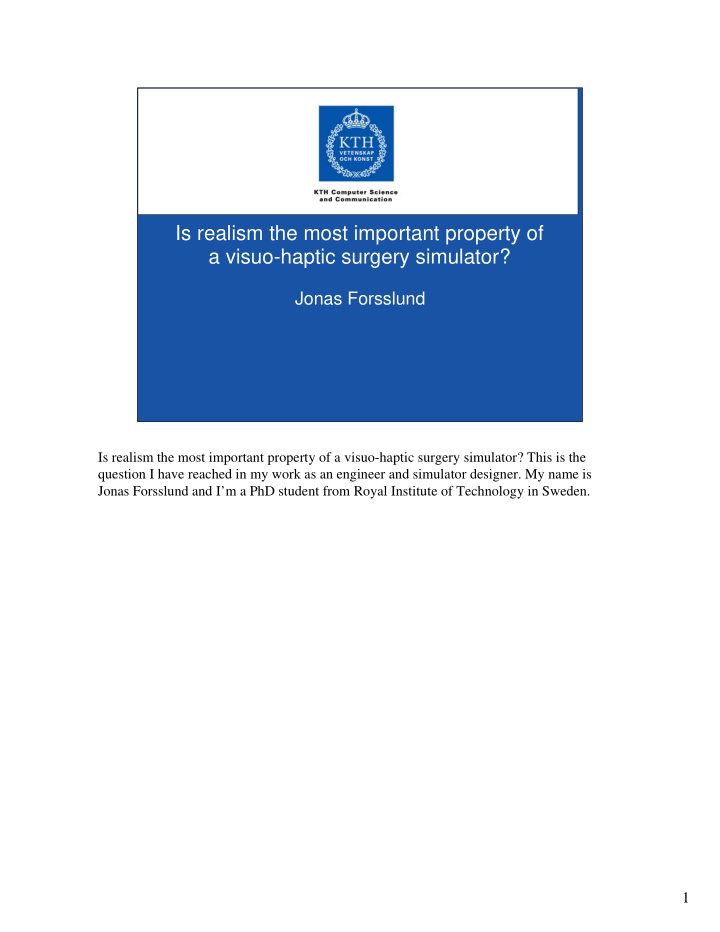



Is realism the most important property of a visuo-haptic surgery simulator? Jonas Forsslund Is realism the most important property of a visuo-haptic surgery simulator? This is the question I have reached in my work as an engineer and simulator designer. My name is Jonas Forsslund and I’m a PhD student from Royal Institute of Technology in Sweden. 1
Introduction We are working in the field of dentistry where we want to help students to make the transition from theoretical learning to hands-on practice. Dental education in Sweden provides lots of practice, but when it comes to oral surgery there is no or minimal practice due to the high costs and lack of willing patients. Still, all dental students are expected to know how to perform surgical extraction of wisdom teeth when they graduate. What is new to most students with this procedure is that you have to remove some jaw bone before accessing the tooth. Then you have to divide it and take it out in parts. 2
The oral surgery simulator This has led us to design and implement a simulator for oral surgery. With this simulator the student can practice in a virtual environment. By using a haptic feedback device the students can to touch and feel the surface of the virtual teeth. A mannequin provides hand support but there are no real teeth, they are only felt using the haptic device. The use of touch in combination with movement to identify objects is called haptic sensing and we use this haptic sensing in combination with stereoscopic vision to convey the shape, position and hardness of the teeth. The setup used here with a mirrored display, as you can see to the right side, lets the user feel the teeth where he sees them. One challenge when developing a haptic virtual environment for dentistry is that the movements are very small while forces can be quite big. This requires a high quality and expensive haptic device, and still unwanted vibrations and other artifacts can be challenging to overcome. The visual appearance of different tissues is basically different shades of white, which also is difficult to represent. And as you can imagine, the projected image of a tooth at this distance from the user, which is the normal distance of real surgery, is very small. 3
realism low cost clarity (for illustration only) In other words, there are always trade-offs in designing this kind of simulator. To paraphrase a common project management triangle, we could have realism, low cost, clarity – pick any two. For example, if you want high realism and clear differences of dental tissue, you will have to put up a very high cost. If you want low cost and realism, you will have to do without this clarity. 4
Studies - Acceptance rate - Instructor qualifications - Observations With that said, we have come quite far with our simulator and it actually provides useful training for students. So useful, that 73% of dental students in one class wanted it to be a permanent part of their education. Another study has been performed with different instructors: a technician, a fellow student and a surgeon, and not surprisingly the best performance is reported with the surgeon as the instructor. But our observations was very giving. Moreover, preliminary observation results shows that the simulator is very much used as a mediating artifact between student and teacher. The simulator facilitates the dialogue between teacher and the student. This helps them to contextualize theory, makes instructions more concrete and makes it possible to teach tacit knowledge like what forces to apply and from what angle. While all these effects come from the usage of a haptic stereoscopic virtual environment, it does not explicitly state that the environment has to be very realistic. In fact, it could even be better with non-realistic features. One such non-realistic feature we have, is the ability to make all soft tissue transparent and allow the teacher to rotate the jaw so it can be viewed from any direction. This feature was used a lot to convey to the student that she has drilled too far into the tongue side of the tooth. 5
Discussion Mediating artifact Non-realism Supporting theoretical understanding through hands-on practice I feel we now are at a crossroad where we can chose to work on ever more realism or we can chose to broaden the design space to include more alternatives. For example, we can choose to shift focus from the simulator as a device that mimics reality to see it as a device that mediates and enhances the reflective discussion between teacher and student. We could for example scale up the teeth and make tissues have very distinct differences in appearance. The question there is of course, would knowledge gain from practice in such environment be transferable to a real setting? 6
Potential designs Perhaps we can take inspiration from professional medical illustrators who have for centuries strived to in a clear and direct way communicate human anatomy to their audience. Such images are still used today although we have the photo and video technology to so to speak create way more realistic images. So, my question to you, as experienced members of this community, is if my top priority as a simulator engineer should be to mimic reality, or if there are more potential in alternative designs that could eventually reduce cost and improve learning. 7
Thank you jofo02@kth.se www.csc.kth.se/~jofo02 And with that question I would like to thank you for listening and hope to continue this discussion. 8
Recommend
More recommend